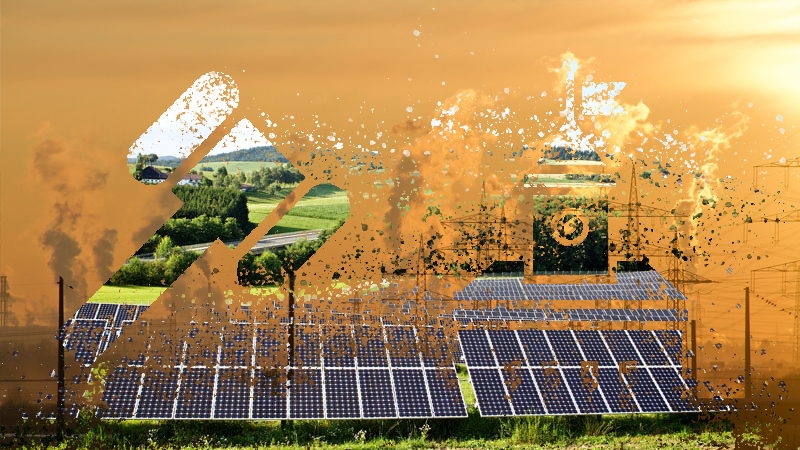UPDATED Feb 6 -It’s been a busy week behind the scenes as we prepare a series of actions targeting utilities bad behavior, and especially fracked fossil gas. I was trying to get my head around some news and new reports, so I wrote a long twitter thread that drew some … unexpected reactions.
I’ve added some more footnotes and images to the long post below, and we’ve launched our first online action connected to this whole story. Click here to tell your Governor to use the Inflation Reduction Act, and crack down on predatory utility companies, so we can have affordable, climate safe communities – not climate chaos and corporate profits. Governors appoint most state utility regulators (lots more on that below!) and can take advantage of the best parts of the Inflation Reduction Act, and not the risky false solutions – but only if they take action.
For those of you who prefer video and visual explanations to footnotes and reading, here’s a too long video explainer, followed (as usual) by a write up with lots of links to sources and news articles
Nobody:
Drew: Let’s do another monster video explainer about utility law and the Inflation Reduction Act!!!
It all started a long time ago, in a tweet far away
This long post started with a simple tweet, from a person I’ve never formally met, looking at a semi-scholarly article on one of the first new Integrated Resource Plans (IRP)— the plan every electric utility has to file with local regulators to say where they plan to get power from, and how much they plan to charge customers for that electricity. Here’s the article, which is about Michigan utility DET Energy’s IRP, one of the first such plans to specifically talk about the Inflation Reduction Act (IRA).
The article, and the person who tweeted it, were both pretty pleased with the DET plan for clean energy. But as longtime readers know, I’ve been skeptical that the IRA will actually benefit the climate or ratepayers as much as *cough* some people. So I fired up the twitter threader, and wrote a reply, since that’s where I’d seen the news. FYI all the articles and reports in this post are in my twitter thread too – I read a lot of utility news and post a lot about what I think of it there. If that’s your jam.
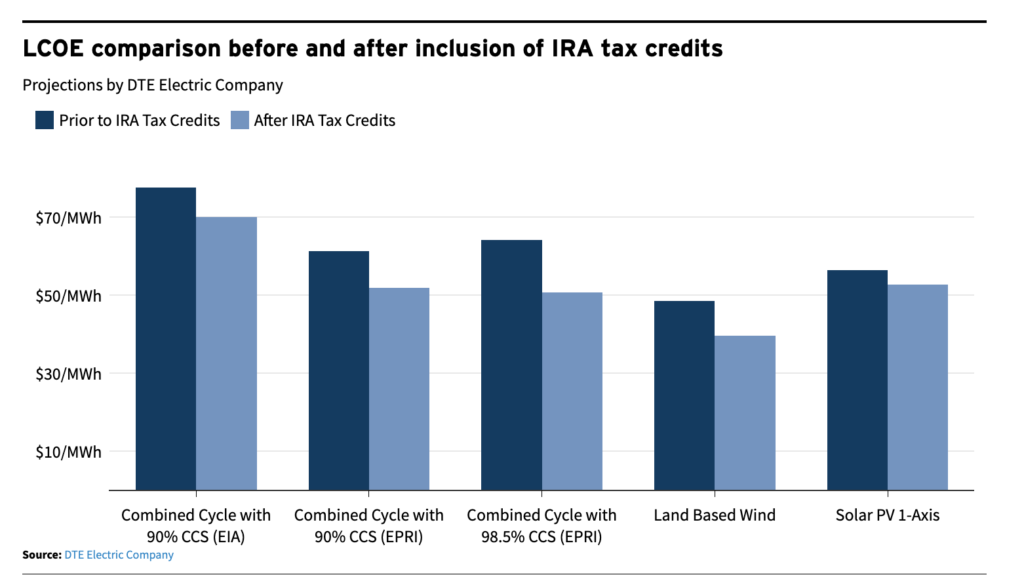
Here’s the gist of my argument:
Sam R of Evergreen Action, and the authors at RMI were all pretty jazzed about the DTE Energy IRP. I think it’s fair to say they would give it at least a passing grade as a “good” IRP that uses a lot of the benefits of the Inflation Reduction Act. And I agree there’s some good news in that plan! Specifically they plan to retire some coal fired power plants earlier than in their 2019 plan, and they have a nice little chart in there showing conclusively that the IRA will lower their cost to invest in new wind and solar power — and also the costs of natural gas, especially with carbon capture technology attached, more on that later.
Altogether, the plan calls for an impressive-sounding increase of renewable energy from 10% of DTE’s supply, to 60% in 2042.
But, last year Michigan Governor Whitmer pledged to that the state would get 60% of its electricity from renewable sources by 2030 and be “carbon neutral” by 2050. And, if you remember those earlier critiques of the IRA, President Biden has previously pledged to eliminate global warming pollution from the electric sector by 2035, as part of his plan to cut emissions 50% by 2030, and to “net zero” by 2050.
So, while 60% by 2042 is clearly better than 10% in 2022, it’s also not nearly enough, or nearly fast enough, to meet the promises President Biden and Governor Whitmer have already made. I could have (maybe should have) just left it there, but I wanted to dig into why this new IRP was failing to achieve the goals, even with the IRA’s massive tax subsidies and incentives.
Again, as we’ve argued all along, there are two basic reasons behind this:
Back in 2021, when the Inflation Reduction Act was still called President Biden’s Build back Better agenda, it included an idea called the Clean Electricity Payment Program. The CEPP was basically a national version of a Renewable Portfolio Standard, it paid utilities to invest in clean energy, and it penalized them if they kept using fossil fuels – more for coal, but also for gas. Our old arch-nemesis, Joe Manchin (Fossil Fueled Fascist, WV) really, really hated the CEPP and, especially since he’s (still) chair of the Senate Energy Committee, he blocked any version of BBB that included penalties for utilities that use fossil fuels.
But that was also a huge part of the climate benefit of the BBB plan (the 45% in the chart below refers to the projection that Biden’s original BBB plan would cut global warming pollution 45% by 2030):
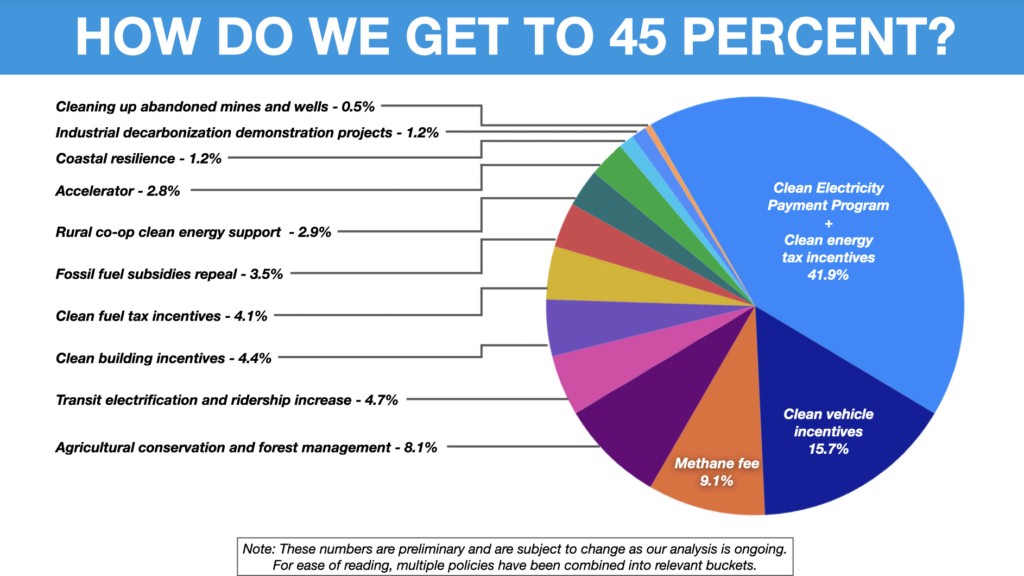
And that’s why we’ve been skeptical that the IRA (with no clean energy payment plan, or other penalties for fossil fuels) will actually achieve the 40% reduction in global warming pollution that advocates (like Same R and his group Evergreen) claim.
And that skepticism bears out in the example of the DET Energy plan that started this whole tweet thread: The chart in that article clearly shows that solar and wind power are cheaper, but the plan still includes building a bunch of new gas-fired power plants because the IRA also makes them cheaper to build – especially if they include the promise of carbon capture and sequestration.
Now, gas burns more cleanly than coal – less air pollution and global warming pollution from the power plant. But that doesn’t account for any of the methane (which is what natural gas is) that leaks from the wellhead, from the pipelines, or from the power plant before it’s burned. That CH4 leakage is a huge problem because it’s 80 times more damaging to the climate than CO2.
It’s also worth noting that there are no working gas power plants with carbon capture right now. So the DET plan is betting an enormous amount of money (to be paid by ratepayers), time, and almost half of the global warming goal on a technology that doesn’t exist today, and which will create a whole bunch of pollution (leaks from the wellhead, to the pipeline, to the power plant door); AND it’s betting that it will be just as cheap as the stuff we already know works (solar and wind).
And that’s the best case scenario (which is why people are excited about it). The worst case scenario looks more like the Duke Energy carbon plan in North Carolina. Again, we’ve told you about this before, but the quick recap is that the legislature passed an ambitious climate plan to reduce carbon dioxide emissions from the power sector 70% by 2030, and achieve “carbon neutrality” by 2050. Duke Energy, the biggest and only name in NC power politics, wrote a plan last year that just doesn’t even come close, and the NC Utilities Commission (NCUC) rubber stamped it “approved” on December 30, 2022. Local advocates gave Duke’s original plan an F grade on a detailed, 12 point scale, and gave the NCUC approval a D minus, because they at least suggested the plan could be improved in the future.
That’s not the bad news. THIS is the bad news
Ok, so the Inflation Reduction Act is incentivizing some new renewables and some reductions in emissions, but not enough or fast enough. Not great, but some progress is better than none, right?
Maybe, but the real poison pill of the IRA is that it gives all the power and money to the same fossil fuel fascists who control the system right now. And when we call these people names, or tell you that they are dangerous, we’re not kidding.
Take DET Energy, the utility with the “Best case” but still bad IRP. According to a new report out this week they shut off the power to 378,000 household and gave their shareholders a $2.1 billion payout.
Duke Energy, not only has a worse carbon plan, but a worse record according to that same “powerless in the US” report they’re responsible for 602,000 household disconnections, and gave their shareholders a $8.3 BILLION payout. This not to mention the fact that Duke’s existing fleet of gas power plants broke down in a cold snap on Christmas eve, 2022, leaving tens of thousands of customers in the dark and cold – and now they want to build even more gas power plants, and charge ratepayers even more money to build them!
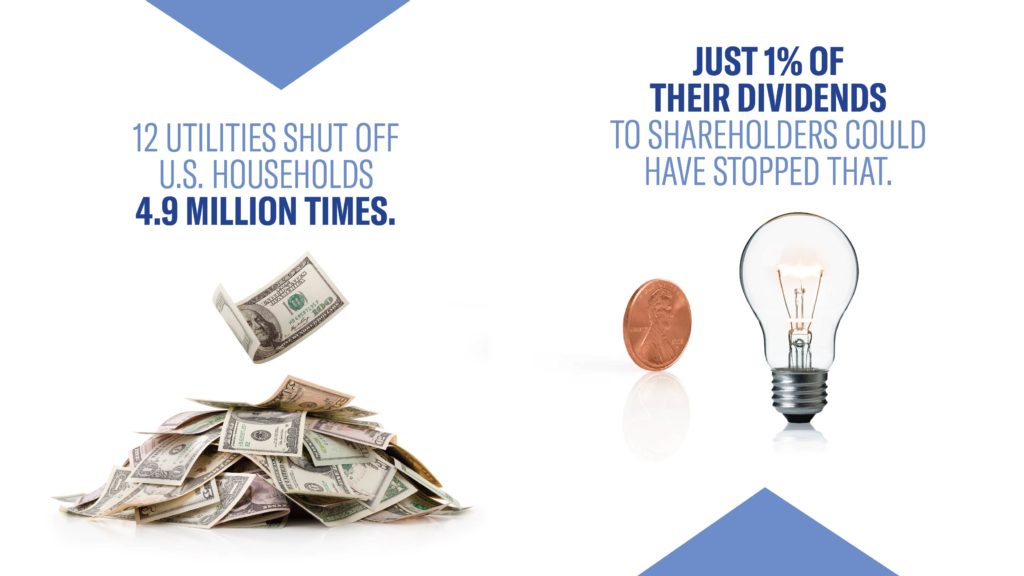
You would think if a monopoly corporation demands payments, shuts off your heat and lights if you fail to pay, shuts off your lights and heat even if you did pay because it’s too cold (or hot, or a climate fueled storm, etc), and then spends all the money you paid them on stock dividends, CEO bonuses, and fossil fuel power plants that specifically violate the state’s climate goals and laws – you would think that somebody in law enforcement would investigate, demand answers, and even hold them accountable.
But the folks who regulate utilities, commonly called Public Utility Commissions or Public Service Commissions (PUC/PSC), are wholly captured by the utilities they’re supposed to regulate. If you’re not familiar with your local PSC/PUC, I highly recommend this report from the Chisholm legacy project that came out a few weeks ago. It has both stories of success and detailed analysis of the problems. And a good list of recommendations at the end.
And at the federal level, of course, it’s our old friends FERC (the Federal Energy Regulatory Commission) who oversee electricity and gas. And as we’ve been telling you for years and years, FERC is a rubber stamp for the gas and utility corporations. A few weeks ago our friends at BXE released new research showing that since March 2022 (around the time the BBB was becoming the IRA) FERC has permitted as much global warming pollution as 76 new coal fired power plants.
And in the last few days the news from FERC and federal energy policy has just gotten worse and worse and worse:
First FERC’s new acting chair Willie Phillips announced that he would no longer require more detailed Environmental Impact Statements on new gas projects. Cowed by fossil fueled fascist Manchin, again, FERC will now only ask for a meager environmental assessment, cutting out community input and ignoring a whole range of environmental and climate impacts. A few days later, FERC approved the re-opening and expansion of the Freeport LNG export terminal in Texas. Freeport had been shut down for months after an explosion last summer sent a fireball hundreds of feet into the air. And FERC still hasn’t explained what, if any, new safety measures have been put in place to protect the community of Freeport.
Freeport is just one part of a massive expansion of the gas industry, especially for exports. As this really clear story from Canary media makes clear, the U.S. is on track to export more liquefied natural gas (LNG) than any other country on earth in 2023 — and it’s still growing. None of which is compatible with climate goals in the US or around the world. Not satisfied with their profits, or the wanton destruction of the climate, the gas industry is spending billions of dollars on bribes, corruption, and misinformation — with a special focus on Democrats in the US — in order to maintain their extortionist control of US energy policy.
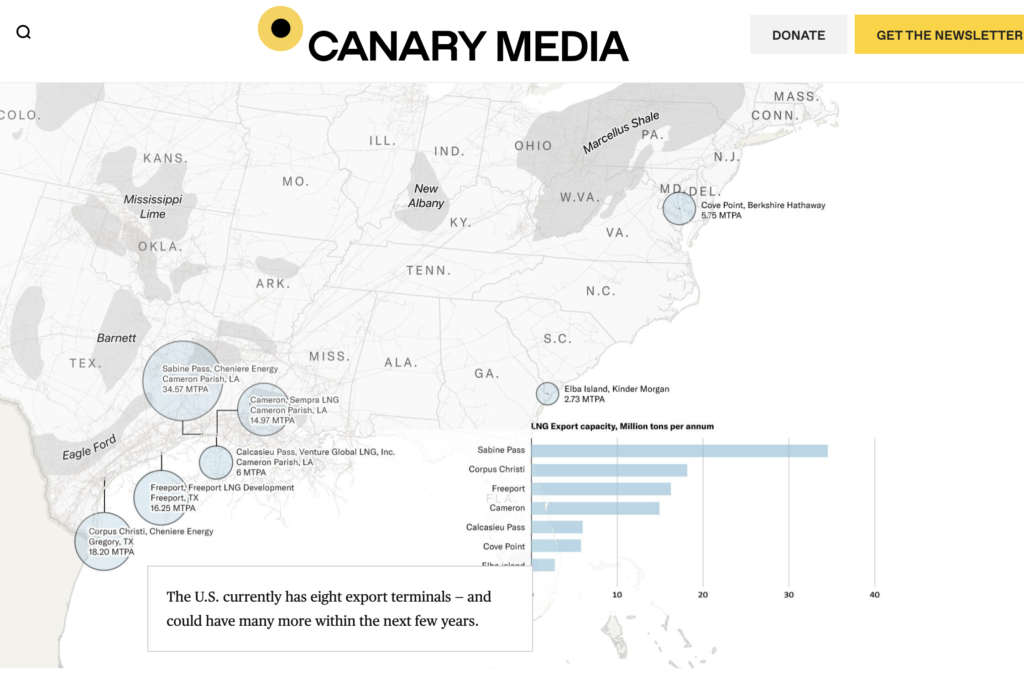
The upshot of all this bad behavior and regulatory corruption is that our utility system, like the police, in the US cannot be reformed – it must be remade. And just like every time I post something about defunding or re-making the police, my tweet about how the IRA would fail because it was trying to reform an exploitive, extractive, violent, system got an angry reply — this time from the head of a very large and important non profit (it’s a major award!).
Trying to be solution oriented
That was the end of my twitter thread, but some of the news is just from Friday Feb 2, 2023, so I wanted to add a bit for today’s post that’s focussed on solutions and what we can do.
The first thing we’ll do at 198 methods, is to stick to radical, non-violent, abolitionist policy and direct action tactics we’ve always done. Part of what Sam from Evergreen misunderstands is that he assumes that important policy has to be made by important people (like him). The fact that he didn’t “see” me when he was meeting with Joe Manchin, or Joe Biden, or whoever last year to create the Inflation Reduction Act is intended as an insult – I wasn’t in the room, so I must not be important enough to have an opinion.
But that’s exactly the kind of thinking that informs Duke and DTE’s energy and climate plans, and the corrupt regulators from the NCUC to FERC who approve them. I’d rather get (non-violently) thrown out of a FERC meeting, a utility commission hearing, or a bank, than sit quietly while they approve fossil fuel projects, shut off power to poor communities, raise our rates, pollute our communities, and send the police to beat or murder us if we get out of line.
The next, and more practical things we’ll do are to keep on keeping on with several projects: Specifically we’ll keep going back to FERC, again and again, demanding they stop approving fossil fuel projects, and that Congress re-make (not reform) the agency into a Federal Renewable Energy commission. And hey wouldn’t you know it, just like Sam from Evergreen didn’t notice what we were doing until it rocked their very posh status quo boat, conservative pro-fossil fuel commentators have also started to pay attention. You know what they say “first they ignore you, then they dismiss you, then they fight you ..” So we’ll also keep on keeping on with our work to defund fossil fuels – specifically by targeting the banks and investors who pour money into the fossil fuel and utility companies (we’ve been a gadfly at several Duke shareholder meetings). There’s a big day of action planned in March (3-21-23, get it?) that we’ll be a part of, and have more actions for you on shortly.
And we’ve got some new ideas – at the end of that Chisholm Legacy Project report there’s a really useful list of all the PUC’s in the country, and all their members – including basic stuff like whether they’re elected or appointed, what their annual budget is, and the demographic and professional background of commissioners. We’d love to use that to build out a plan to attend, disrupt, and challenge PUC authority in lots of states. We had a whole plan for an event this week in North Carolina, but the NCUC and Duke participants pulled out at the last minute. We’ll need a lot of help and partners to make this work in more than a few states too. In a similar vein, we’d love to watchdog more IRPs and carbon plans – Minnesota just passed a 100% clean energy standard this week – to make sure that they actually live up to the hype.
